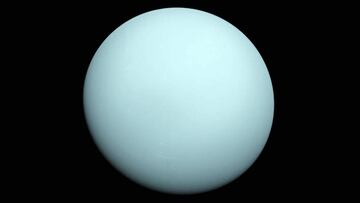Why is it important for NASA to send a mission to Uranus?
NASA has been urged to make a mission to the planet Uranus a number-one priority in the decade ahead, as scientists aim to further their knowledge of ice giants.


A new report by a panel of top scientists says a dedicated mission to Uranus, the seventh planet in our solar system, will allow us to gain unprecedented insight into so-called ‘ice giants’ - a type of planet we now understand to be prevalent in the universe.
Mission to Uranus should be NASA’s number-one priority, says National Academies
Released on Tuesday by the US’ National Academies of Sciences, Engineering and Medicine, the 780-page report advises NASA to prioritise a mission to send an orbiter and probe to Uranus in the decade ahead. “Uranus is one of the most intriguing bodies in the solar system,” it says.
Entitled ‘Origins, Worlds, and Life: A Decadal Strategy for Planetary Science and Astrobiology 2023-2032′, the National Academies’ findings are the latest in a series of reports published by the organisation every 10 years, with recommendations to NASA on where its immediate focus should lie.
The next decade of planetary science and astrobiology will explore our solar system’s origins, how planets evolve, and where life might be found in our solar system and beyond.
— National Academies (@theNASEM) April 19, 2022
Learn more by checking out the #PlanetaryDecadal digital summary at https://t.co/qwVu3BBcmi pic.twitter.com/0GGXBSgG6u
Previous report recommended Uranus visit behind Mars, Europa missions
The National Academies’ previous study, published in 2011, placed a mission to Uranus as the third-highest priority. At that time, the body considered the two most pressing projects to be a mission to bring back rocks from Mars, and a visit to Jupiter’s ice-covered moon Europa, which scientists believe has a potentially inhabitable ocean of liquid water underneath its surface.
In February 2021, the Perseverance Rover landed on Mars tasked with collecting rock samples to be returned to Earth, while the Europa Clipper is set for launch in October 2024, with “one overarching goal”, NASA says: to “determine if Europa harbors conditions suitable for life”.
So far, there hasn’t been a dedicated mission to Uranus or Neptune, which are our solar system’s two ice giants - a variety of planet defined by NASA as chiefly consisting of “a hot, dense fluid of ‘icy’ materials - water, methane and ammonia - above a small rocky core”. The closest a manmade spacecraft has come to Uranus is when the Voyager-2 probe flew past the planet in January 1986, at a distance of about 50,000 miles.
Uranus: fact file
- Discovered in 1781 by astronomer William Herschel
- Named after the Greek god of the sky
- Orbits the Sun at a distance of about 1.8 billion miles
- Takes 84 Earth years to complete on orbit of the Sun
- Surrounded by 13 known rings
- Has 27 moons, the largest of which is Titania
- Is the only planet in our solar system to rotate on its side
Ice giants “likely the most common” type of planet
However, the growing search for exoplanets - planets that orbit a star other than the Sun, of which some 5,000 have been discovered since the mid-1990s - has highlighted the importance of gaining a better understanding of ice giants.
Although ice giants are in the minority in our solar system, the study of exoplanets has shown that they “are likely the most common class of planets in the universe,” Robin Canup of the Southwest Research Institute, who was co-chair of the steering committee for the decadal report, told NPR. Canup added: “We saw this mission as delivering absolutely transformative, breakthrough science because we know so little about these systems. We are sure there are going to be lots of surprises once we get there.”
“UOP [a Uranus orbiter and probe] will provide ground truth relevant to the most abundant, similarly sized class of exoplanets,” the National Academies’ study says.
Mission would help plug gap in knowledge on planet formation
Another scientist who participated in the publication of the report, Professor Leigh Fletcher of Leicester University, notes that the apparent abundance of ice giants like Uranus - which is roughly four times wider than Earth - “poses a problem for planet formation theories”.
“We think we understand how something gets as big as Jupiter [a gas giant over 10 times as wide as Earth], and we think we understand how something gets to be the size of Earth and Venus,” Professor Fletcher told the BBC. “But in the middle, in that kind of sweet spot between those end-members - we don’t fully understand how a world can start to grow and grow and not just carry on to become Jupiter-mass in size. A mission to Uranus could help us answer that.”
Uranian moons could further search for extraterrestrial life
Related stories
A Uranus mission could also play a role in the search for life beyond Earth. The planet’s largest moons - Miranda, Ariel, Umbriel, Titania and Oberon - are described by the National Academies as being, like the Jovian moon Europa, “potential ocean worlds”. “Investigation of these moons would enhance our knowledge of where potentially habitable bodies exist in our solar system,” Chloe Beddingfield of NASA’s Ames Research Center told Space.com.
2031, 2032 the best time to launch Uranus mission
According to the National Academies, the “optimal launch opportunities” for a mission to Uranus would be 2031 or 2032. If launched during this period, the orbiter and probe would benefit from a gravitational push from Jupiter, leading to a shortened journey time estimated at about 13 years.

